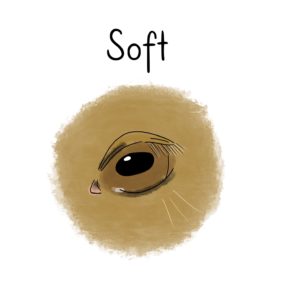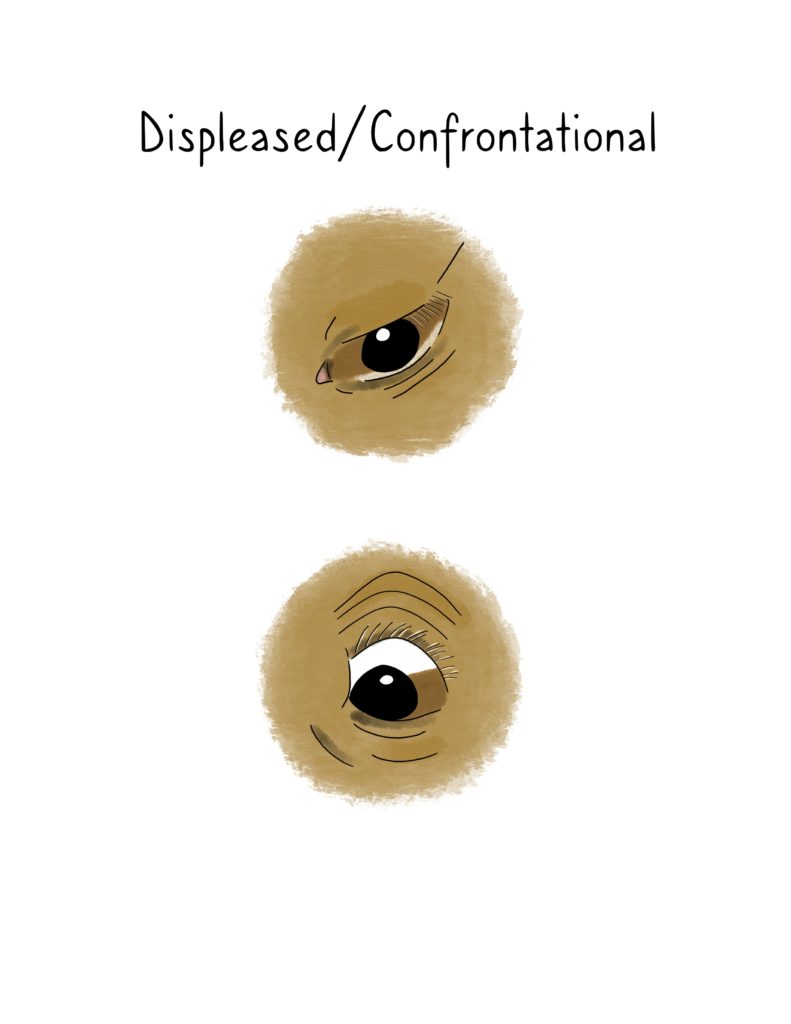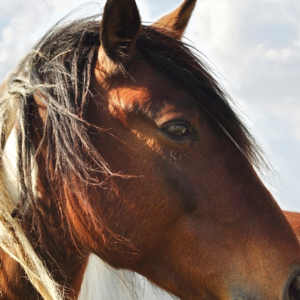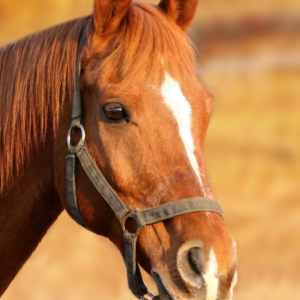
If you provide care for horses at your sanctuary, then understanding their body language is vital to successful relationships and care practices. While horses have different vocalizations that communicate important information, their body language can also provide vital insight into their emotional states and health. However, this is only true if we can interpret them correctly! This resource is part of a series on horse body language and briefly introduces the different ways horses communicate with their eyes. Through this series, you will learn to identify different possible meanings behind ear/tail/mouth/eye/head/limb and body positions and how context and the combination of these body positions can provide a fuller picture of what a horse is expressing. First, let’s take a general look at body language in horses before taking a closer look at eye positions.
Body Language
Understanding a resident’s body language can allow you to catch early signs of illness or recognize social issues among the herd that may be negatively affecting a resident. Body language can also tell much about a resident’s comfort level around different human and nonhuman individuals during different situations. Correctly interpreting a resident’s body language can make it easier to understand their preferences and concerns and better anticipate their needs in a variety of spaces and situations. This allows caregivers to tailor situations and their own behaviors to meet the individual’s needs better. In short, body language is essential to know!
In horses, there are multiple elements of body language to pay close attention to. Some of the areas to pay attention to, such as ears, tails, and body, may be familiar. You might be surprised to learn that muscle tightness in the cheeks and around a horse’s eyes and mouth can provide a lot of information, as can the presence of wrinkles around their eyes! Other areas to notice are the chin, mouth, overall head and neck carriage, and the placement of their limbs. As you can see, there is a lot to learn regarding horse body language. While each of these areas can provide some information about an individual, the whole of them read together will give the best overall interpretation. Failure to account for all the body language being expressed by an individual and the context of a situation can result in a faulty interpretation. This can have negative, even dangerous, consequences for the resident and staff.
But what do you look for in terms of eye expression, and what can it mean? Let’s take a closer look!
Eye Expressions In Horses
You can tell a lot from looking at a horse’s eyes!
The Full Picture Is Necessary
While this series is broken down into more easily digestible resources meant to make learning about horse body language easier, it is VITAL that you learn about all of their body language when trying to interpret what they are saying and before acting. Only focusing on one body part to understand what they are expressing could result in a misunderstanding that could have disastrous results.
Example: George, a horse resident, is standing in a stall with his ears pricked forward. A caregiverSomeone who provides daily care, specifically for animal residents at an animal sanctuary, shelter, or rescue. only looking at his ears might say, “George is curious about the new visitors,” and attempt to go in with him. George spooks and backs up quickly when their caregiver opens the door. What did they miss?
If the caregiver had taken in other aspects of his body language, they might have noticed the step back he had taken, the tension in his body, the whites of George’s eyes, and the snort he vocalized, among other signs of concern. These additional factors indicate George’s concern and fear of a potential threat. Turns out, George was surprised by and alarmed by the large sunhat a visitor was wearing, not simply curious about the newcomers.
If you care for horse residents, you know that their eyes are large, lovely, and prominently situated on either side of their head. This placement gives horses an impressive field of view, allowing horses to see 350 degrees around them! A grazing horse can see both the ground AND the horizon simultaneously. Horses have both monocular vision, meaning they can see different things with each eye, and binocular vision, meaning they can focus on the same thing with both eyes. Below, the blue and yellow areas represent what a horse can see. The light purple area just in front of their nose and directly behind them are their true blind spots. They have limited vision in the light pinkish area

An interesting horizontal pupil sits within a horse’s irises, usually shades of brown or, less commonly, blue (and rarely green in some breeds). The cornea is rounded out and prominent, making them vulnerable to injury. Care should always be taken to assess eye health. Ask your veterinarian how to check for injury or eye disease and include this in health checks. Check out our resource to learn a little more about the general anatomy of a horse’s eye.
Abnormal Eye Conformation
Some horses may have sustained an injury that changed the appearance, ability, and/or conformation of their eye and/or orbital area. As a result, their eye or orbital area may not look or move the same as a typical horse’s eye. Sadly, there are a number of eye diseases and injuries that may affect a horse and their ability to use it to communicate. It is also important to note that the absence of vision or the presence of discomfort or pain in the eye or the surrounding area can affect whether they feel comfortable and safe. This can result in a resident communicating their discomfort or fear, which will present in other areas of the body. This is why it is VITAL to have a good understanding of their body language overall.
In these cases, caregivers must take care to learn what movement their eye and the orbital area is capable of and what their position may mean for that individual. Understanding horse eye and orbital muscle placement can also help you detect new injuries or illnesses and treat them immediately. Applying a general concept of horse communication through eye expression may not be effective in situations where injury or disease prevents normal eye movement or presentation and could lead to misunderstandings and an unhappy resident. Remember, all residents are individuals, and while learning their species-specific behaviors is vital, so is learning about the individual. In that case, you would have to rely on other body signals, the context of the situation, and vocalizations to understand what is being expressed.
While the whole meaning of eye and orbital muscle positioning comes with context and understanding of tail, ear, nose, mouth, limb, body, and head positions (in addition to other things), there are some basic positions to know! You will see a bit later how the combination of the different positions can provide a fuller picture of what their body language is “saying.”
Soft Eyes Vs Hard Eyes
Soft eyes are generally seen when a horse is feeling comfortable and not focusing intensely on something or someone. If they feel unsure whether a threat is present, you may see “hard eyes.” The difference is in the tension or lack thereof around the eyes and other body areas. Tension around a horse’s eyes can look like wrinkles, their body may be tense, and their nostrils may be elongated instead of round. You may also see the tension in their cheek muscles, wrinkles around their mouth, ears pricked forward with tension or laid back or out to the sides depending on whether the driving emotion is fear, annoyance, anxiousness, etc.
A good way to understand this is by looking at an object across the room, outside in a garden, or watching a bird in the sky. If you were looking at a plant and thought you saw a butterfly behind a leaf, but you were concerned it was another individual munching away on all the leaves, you might focus all your attention on that plant looking for them to reemerge. In this case, you might notice tension around your eyes and throughout your body. Pay attention, and you might notice that you have entirely stilled and may even be holding your breath. Now picture walking out to the garden and just looking at the whole of it. You notice an especially lovely flower and then continue enjoying the view of all the plants. Your eye may be consistently drawn back to the flower you favor, but your focus is expanded to the world around you. Notice if your body lacks tension, your eyes feel “soft,” and you are still breathing.


Calm, Neutral Eyes
Calm eyes are soft eyes. If a horse feels calm and comfortable, their eyes will reflect this. Their eyes will be soft, and their eyelids won’t be wrinkled. Remember, there can be one soft wrinkle in the upper eyelid, which is normal. What you won’t see in a calm and comfortable horse are wrinkles on the upper lid that look like an upside-down “V.” Most horses have sclera (the whites of their eyes) that only show when they are stressed, excited, fearful, or looking far in one direction. Appaloosas and Ponies of America are more likely to have the whites of their eyes showing even when feeling calm or neutral, and there are always individual cases in other breeds. This is why it is important for you to know what their individual baseline facial expressions are. Their body will lack tension, and their ears may be up or swiveling toward other sounds, but the ears too will lack tension. Their tail will generally be relaxed, lacking tension, and laying vertically. They may be swishing it around if there are flies present. (This tail swishing looks different than tail swishing seen when they are irritated or displeased). Their head won’t be reared back high, their body won’t be tense, and they will be aware but comfortable with their surroundings.

Dozing, Sleepy Eyes
A horse that is dozing can often present with relaxed (lacking wrinkles or the whites of their eyes) half-closed or entirely closed eyes, though they still might have their eyes open. Their neck and head will likely hang lower, they may have a leg slightly lifted, and their ears may be relaxed out to the side a bit. You may also notice that their face is without tension, and their bottom lip may droop. It is important to avoid approaching them in a way that might cause startlement. If a horse’s tail is lax, laying vertically, and their ears are out to the side without tension, their lips drooping, their eyelids are relaxed or closed, and they are standing with a leg lifted slightly, they may be dozing. Be careful not to startle them by walking up to them unexpectedly. It is also important to learn the difference between a horse dozing while resting a leg and a horse holding up their leg due to pain or discomfort. A horse will be hesitant to put their full weight on a leg or hoof that is injured or if they have laminitis. Their gaitA specific way of moving and the rhythmic patterns of hooves and legs. Gaits are natural (walking, trotting, galloping) or acquired meaning humans have had a hand in changing their gaits for "sport". (how they walk) will look different, and the hoof or leg may show signs of swelling, heat, or apparent injury. There are additional signs of pain to look out for as well. If you are concerned, consult your veterinarian as soon as possible.

Alert, Curious Eyes
An alert, curious horse may have their eyes wider, focusing on what they are curious about. This is a “hard” eye. If they are ascertaining if the sound, movement, object, or nonhuman or human animal is a threat, their eyes may be fixed in a harder stare. If they have some concerns, there will be some mild wrinkling of the eyelid. Once they are certain it isn’t a threat, their eyes may grow softer but still fixed. They may move forward towards the object of their curiosity to get a better look, smell, and so on. Generally, if they are closer, a curious but comfortable horse will also display a lifted head or a head reaching out to the subject of interest. This will look different than a bite threat where their neck would be stretched out, their ears pinned back, their eyes harder, and with wrinkles and possibly the sclera showing.
If a horse resident is alert and curious, their tail may stiffen or be held out or up a bit, depending on their level of interest and alertness. Their ears will be pricked forward (up and forward-facing). You might notice this when a resident sees someone coming into sight, hears a noise, or is otherwise alerted to or curious about a change in their environment. They will lack the tension in muscles around their eyes, cheek, and body that would occur when they are concerned about a possible threat. They may stretch out their neck to sniff or otherwise investigate the subject of interest. If they reach out their neck towards a human or other horse, their ears are back, and their lips are pulled back, this could signify displeasure and bite threat.

Anxious, Stressed, Or Concerned Eyes
In some horses, the whites of the eyes are always present. However, in many horses, the whites of their eyes indicate, at the very least, startlement or mild upset and, at the most, fear and panic. An anxious or stressed horse will have wrinkles above their eyes shaped like an upside-down “V.” The higher the stress level, the more wrinkles they will get (even under their eyes), and their eyes may widen. If a horse resident feels more alarmed than curious, their ears will still be up and forward-facing. You may also notice tension in their cheek muscles and tail (which may be held out stiffly or flagged). They may also pace or vocalize, alerting others to a potential threat or calling out to a companion they are separated from.


Notable Breed Characteristics
Certain horse breeds, namely Appaloosas and Ponies of America, are more likely to have eyes that naturally present more sclera (whites of the eye) in a neutral state. It is important to take breed into consideration, as well as individual variations when assessing eyes. Some individuals, regardless of breed, just naturally have the whites of their eyes more visible than others.
Fearful, Extremely Stressed, Or Panicky Eyes
If the previously slightly stressed horse becomes fearful, panicky, or extremely stressed, the whites of their eyes may become more prominent, there will be increased eyelid wrinkles, and their stare will be hard. The white of their eyes will likely be visible, indicating extreme stress, displeasure, or fear.

Extremely Displeased Or Confrontational Eyes
A horse’s eye may become “harder” if they are extremely displeased or feel confrontationalBehaviors such as chasing, cornering, biting, kicking, problematic mounting, or otherwise engaging in consistent behavior that may cause mental or physical discomfort or injury to another individual, or using these behaviors to block an individual's access to resources such as food, water, shade, shelter, or other residents.. They may narrow or become quite wide, depending on the action they are taking and the exact emotions they are feeling. The best way to tell is by observing other body cues such as pinned ears, tossing their head, strained muscles in their cheeks, the whites of their eyes visible, and other behaviors or body language. They will pin their ears back; the further back, the more unhappy they are with the situation. Their tail may all stiffen and raise and stick out a bit, or if they are preparing to buck or kick, their tail may be tucked in preparation. While all the above states should be taken seriously and steps should be taken to lower any discomfort or anxiety, this body language is a grave warning that they are especially displeased, and whatever is happening to make them feel threatened or uncomfortable should stop immediately before they begin defensive behaviors (pulling back, rearing, kicking, biting, and/or blindly fleeing) or offensive (kicking, biting, stomping, or charging) measures in an attempt to stop whatever it is that is upsetting them.
You may observe their head tucking down, their body bracing to kick out with their back legs, or their head sticking straight out and their teeth bared to bite someone. They may also swing their head in displeasure or lift their head and back up to try and remove themselves from the situation.

Playful, Excited Eyes
Playing often resembles confrontational behaviors. The whites of a horse’s eyes may show while playing or otherwise excited. A horse’s sclera could also show while they are looking far off in one direction or the other. A horse resident may flag (raise) their tail if they feel excited and “spirited.” This is a sign of positive feelings. However, a horse resident may be truly alarmed by something and flag their tail. In this case, this would be a sign of negative feelings. It is important to look at other body language and the context of the situation. Are they prancing around the pasture when they catch sight of their companion returning from the vet? They may be eager, excited, and even a little anxious about reuniting with them quickly. Is their companion being led away and loaded into a trailer? They may be seriously alarmed and afraid.
Is this a young horse interacting with a favored companion? Are they playing? Playing often looks a lot like confrontation and can be alarming to see. However, play behavior is unlikely to result in serious injury and often lacks the intensity that is seen during confrontational behaviors. It is always important to remember that play can result in injury if one or both of the individuals has health issues or there is a big size difference or varying levels of interest in the play.
Pain And Discomfort Eyes
Horses who are in pain generally have wrinkles above (and often below) their eyes. Their eyes may be open or almost squinting. It is important to remember there are others reasons for a horse to have eye wrinkles or to have their eyes partially closed. A horse may be dozing and have their eyes partly or completely closed. Their eyes will lack the wrinkles and tension you might see in a horse in pain or stress. Other signs of pain include the ears, which may face out and back, and their mouth and cheeks, which may present with a tightening of the muscle in the cheeks or around their mouths. Disinterest in eating and/or engaging with companions can be a sign something is wrong, as can a lack of interest in/reaction to their environment. Check for signs of any obvious injury, if they favor a leg, have swollen, hot, or tender joints, or are pawing at the ground, biting at their sides, or rolling on the ground. The former can be signs of laminitis, while the latter can be signs of colic.


Depressed Eyes
A depressed horse may present with dull eyes and a fixed stare. Other signs they are depressed may present as isolating themselves from others, facing a wall, and extending their neck and head so that it lines up horizontally with their back. They may also not respond to touch or food or even offered treats. A horse resident’s ear may droop out to the side, sometimes described as airplane ears, when depressed or in pain. A horse resident’s ears may also seem a bit droopy when they are especially relaxed. Because of this, it is important to become familiar with each individual resident and learn how to identify signs of depression. Disinterest in eating and/or engaging with companions can be a sign something is wrong, as can a lack of interest in/reaction to their environment.
The Full Picture
As you may have noticed, eye expressions can sometimes look quite similar but express different emotional states. To get the full picture of what a horse resident is trying to “say,” it is important to understand the context of the situation you are witnessing. While the above is a good introduction to horse body language and can certainly help you have a better idea of what your horse residents may be experiencing or expressing, you will learn through this series on body language that context is important, as is having a good understanding of horse behavior and recognizing nuances in body language and behavior. Knowing about ear, tail, head position, body posture, and eye, nose, and mouth movements will give you a clearer picture of what is being “said.” For now, observe your horse residents and see what their eyes tell you!
SOURCES
Understanding Your Horse’s Body Language | RSPCA
The Basics of Equine Behavior | Rutgers University (Non-Compassionate Source)
How To Read Your Horse’s Body Language | Equus Magazine (Non-Compassionate Source)
Can Wrinkles Above The Eye Tell Us How A Horse Is Feeling? | Equine Behaviorist (Non-Compassionate Source)
Emotion Recognition In Horses With Convolutional Neural Networks | Animals (Non-Compassionate Source)
The Eyes And Ears Are Visual Indicators Of Attention In Domestic Horses | Current Biology (Non-Compassionate Source)
Are Eyes A Mirror Of The Soul? What Eye Wrinkles Reveal About A Horse’s Emotional State | PLOS ONE (Non-Compassionate Source)
Equine Body Language: 7 Signs to Recognize | The Horse (Non-Compassionate Source)
Equine Behavior: A Guide For Veterinarians And Equine Scientists | Paul McGreevey, Professor Of Animal Behavior And Welfare, University Of Sydney (Non-Compassionate Source)
EquiFACS: The Equine Facial Action Coding System | PLOS ONE (Non-Compassionate Source)
Horse Reactions To Human Attitudes And Behavior |Antrhozoös (Non-Compassionate Source)
Facial Expression And Oxytocin As Possible Markers Of Positive Emotions In Horses | Scientific Reports (Non-Compassionate Source)
Horse Body Language | Extension Horses (Non-Compassionate Source)
Non-Compassionate Source?
If a source includes the (Non-Compassionate Source) tag, it means that we do not endorse that particular source’s views about animals, even if some of their insights are valuable from a care perspective. See a more detailed explanation here.


































